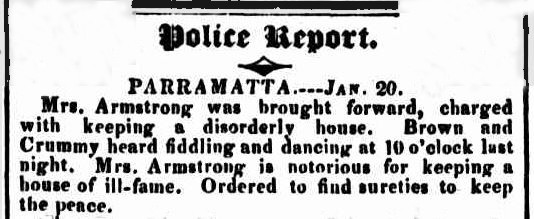ABBOTT, John
Two escaped prisoners dancing
Ann Sneid, alias Puckeridge, was charged with harbouring two men, named George Wright and John Abbott, two prisoners of the Crown illegally at large in her house. On the evening of the fourth instant, Sutland, the informer, stated, that hearing some noisy fracas at the defendant’s house, he was induced to go in, when seeing the two prisoners, dancing, and the door being on the jar, he popped in, and tapping the pair of customers on the shoulder, brought them out, and walked off both to the watch-house. Proof of the conviction of these men was then gone into.
In defence to this information, the defendant urged that she was not the occupant of the house in question, and in support of this tendered in proof an affidavit to that effect, backed by another from the individual to whom she had let it. The Bench, however, could not be brought to believe but that the defendant was the bona fide occupier of the house — as she lived in it with her daughter, the house belonged to her, and the individual whom she named as being the person she had let it to, not being in a situation of life to make it at all likely he could be in want of a place of the description. The fact, they thought, was, that one had money, and the other none. Sentenced to pay a fine of 25 dollars to the King, and two dollars for each prisoner so harboured, with cost of summons, &c. —or in default of payment, within three days, to stand committed to gaol for two calendar months.
POLICE INCIDENTS. (1829, February 13). The Australian (Sydney, NSW : 1824 – 1848), p. 3. Retrieved December 16, 2018, from http://nla.gov.au/nla.news-article36865952

“For blythe & merry we’ll be a.”
“And dance till we be like to fa”
Young people dancing in a barn, Robert Thomas Stothard (1823) London © The Trustees of the British Museum
APPLEBY, Charles
Dancing what he called an … pas seul
MONDAY_Charles Appleby was handed to the bar black as the book of night. Charley set forth, for coming it strong, while suffering under coercion from Hodges invincible, Charles was found dancing what he called an improvement upon Mrs. Weston’s pas seul, to the tune of ” hot, hot, all hot,” melodiously ground out of the windpipe of a vendor of mutton pies. ” Who are you, sir,” said the charley, ” I, why ain’t I .Charles Appleby.” ” You may be apple pie or mutton pic for what I care,” rejoined charly, but you must favor me with your company. ” Who, I; what I, sir, why d-e, sir, I m not to be had ; p-h-o.” ” It won’t do, my hearty, so come along,” and the renowned Charles Appleby was under the necessity of lodging for one night in the lock-up. Charles, when called upon for his defence, said he did not wish to extenuate, he would leave it to their Lordships Worship, who sent him to play ballet master at Murray’s assembly rooms* for 14 days.
*A satirical name for the Treadmill – it was comically referred to as the dancing academy. Andrew Murray was the superintendent of the Carters’ Barracks from 1827 to 1834 and was in charge of the government treadmill (near today’s Central Station).
POLICE INCIDENTS. (1833, February 7). The Sydney Herald (NSW : 1831 – 1842), p. 3. Retrieved December 16, 2018, from http://nla.gov.au/nla.news-article12846203
ARMSTRONG, Mrs.
Fiddling and dancing at 10 o’clock last night
Parramatta 20 January 1827
Mrs. Armstrong was brought forward, charged with keeping a disorderly house. Brown and Crummy [constables] heard fiddling and dancing at 10 o’clock last night. Mrs. Armstrong is notorious for keeping a house of ill-fame. Ordered to find sureties to keep the peace.
 Police Report. (1827, January 23). The Sydney Gazette and New South Wales Advertiser (NSW : 1803 – 1842), p. 3. Retrieved January 30, 2017, from http://nla.gov.au/nla.news-article2187471
Police Report. (1827, January 23). The Sydney Gazette and New South Wales Advertiser (NSW : 1803 – 1842), p. 3. Retrieved January 30, 2017, from http://nla.gov.au/nla.news-article2187471
ASHMORE, John
Dancing after hours 1834 Sydney
John Ashmore, assigned to a person in Liverpool street, was placed at the bar charged with being found in a house in Frazier’s-lane, on the Rocks, after hours, tripping on the light fantastic toe, to the tune of ” Britons never will be slaves.” Thirty-six lashes.
POLICE INCIDENTS. (1834, September 15). The Sydney Herald (NSW : 1831 – 1842), p. 1 (Supplement to the Sydney Herald.). Retrieved January 2, 2017, from http://nla.gov.au/nla.news-article12850439


